Manaal Faruqui
Shammie
What Matters for Model Merging at Scale?
Oct 04, 2024



Abstract:Model merging aims to combine multiple expert models into a more capable single model, offering benefits such as reduced storage and serving costs, improved generalization, and support for decentralized model development. Despite its promise, previous studies have primarily focused on merging a few small models. This leaves many unanswered questions about the effect of scaling model size and how it interplays with other key factors -- like the base model quality and number of expert models -- , to affect the merged model's performance. This work systematically evaluates the utility of model merging at scale, examining the impact of these different factors. We experiment with merging fully fine-tuned models using 4 popular merging methods -- Averaging, Task~Arithmetic, Dare, and TIES -- across model sizes ranging from 1B-64B parameters and merging up to 8 different expert models. We evaluate the merged models on both held-in tasks, i.e., the expert's training tasks, and zero-shot generalization to unseen held-out tasks. Our experiments provide several new insights about model merging at scale and the interplay between different factors. First, we find that merging is more effective when experts are created from strong base models, i.e., models with good zero-shot performance. Second, larger models facilitate easier merging. Third merging consistently improves generalization capabilities. Notably, when merging 8 large expert models, the merged models often generalize better compared to the multitask trained models. Fourth, we can better merge more expert models when working with larger models. Fifth, different merging methods behave very similarly at larger scales. Overall, our findings shed light on some interesting properties of model merging while also highlighting some limitations. We hope that this study will serve as a reference point on large-scale merging for upcoming research.
Foundational Autoraters: Taming Large Language Models for Better Automatic Evaluation
Jul 15, 2024Abstract:As large language models (LLMs) advance, it becomes more challenging to reliably evaluate their output due to the high costs of human evaluation. To make progress towards better LLM autoraters, we introduce FLAMe, a family of Foundational Large Autorater Models. FLAMe is trained on our large and diverse collection of 100+ quality assessment tasks comprising 5M+ human judgments, curated and standardized using publicly released human evaluations from previous research. FLAMe significantly improves generalization to a wide variety of held-out tasks, outperforming LLMs trained on proprietary data like GPT-4 and Claude-3 on many tasks. We show that FLAMe can also serve as a powerful starting point for further downstream fine-tuning, using reward modeling evaluation as a case study (FLAMe-RM). Notably, on RewardBench, our FLAMe-RM-24B model (with an accuracy of 87.8%) is the top-performing generative model trained exclusively on permissively licensed data, outperforming both GPT-4-0125 (85.9%) and GPT-4o (84.7%). Additionally, we explore a more computationally efficient approach using a novel tail-patch fine-tuning strategy to optimize our FLAMe multitask mixture for reward modeling evaluation (FLAMe-Opt-RM), offering competitive RewardBench performance while requiring approximately 25x less training datapoints. Overall, our FLAMe variants outperform all popular proprietary LLM-as-a-Judge models we consider across 8 out of 12 autorater evaluation benchmarks, encompassing 53 quality assessment tasks, including RewardBench and LLM-AggreFact. Finally, our analysis reveals that FLAMe is significantly less biased than these LLM-as-a-Judge models on the CoBBLEr autorater bias benchmark, while effectively identifying high-quality responses for code generation.
Leave No Context Behind: Efficient Infinite Context Transformers with Infini-attention
Apr 10, 2024Abstract:This work introduces an efficient method to scale Transformer-based Large Language Models (LLMs) to infinitely long inputs with bounded memory and computation. A key component in our proposed approach is a new attention technique dubbed Infini-attention. The Infini-attention incorporates a compressive memory into the vanilla attention mechanism and builds in both masked local attention and long-term linear attention mechanisms in a single Transformer block. We demonstrate the effectiveness of our approach on long-context language modeling benchmarks, 1M sequence length passkey context block retrieval and 500K length book summarization tasks with 1B and 8B LLMs. Our approach introduces minimal bounded memory parameters and enables fast streaming inference for LLMs.
Gemini: A Family of Highly Capable Multimodal Models
Dec 19, 2023Abstract:This report introduces a new family of multimodal models, Gemini, that exhibit remarkable capabilities across image, audio, video, and text understanding. The Gemini family consists of Ultra, Pro, and Nano sizes, suitable for applications ranging from complex reasoning tasks to on-device memory-constrained use-cases. Evaluation on a broad range of benchmarks shows that our most-capable Gemini Ultra model advances the state of the art in 30 of 32 of these benchmarks - notably being the first model to achieve human-expert performance on the well-studied exam benchmark MMLU, and improving the state of the art in every one of the 20 multimodal benchmarks we examined. We believe that the new capabilities of Gemini models in cross-modal reasoning and language understanding will enable a wide variety of use cases and we discuss our approach toward deploying them responsibly to users.
AutoMix: Automatically Mixing Language Models
Oct 19, 2023

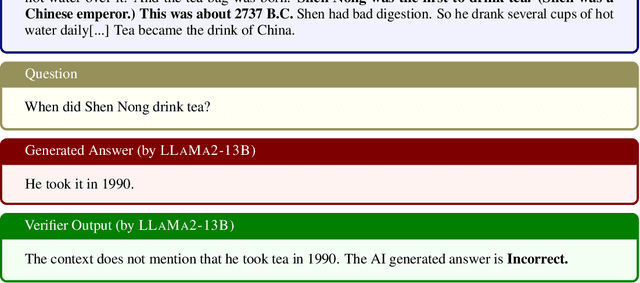
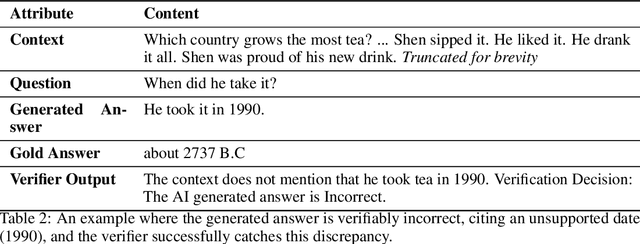
Abstract:Large language models (LLMs) are now available in various sizes and configurations from cloud API providers. While this diversity offers a broad spectrum of choices, effectively leveraging the options to optimize computational cost and performance remains challenging. In this work, we present AutoMix, an approach that strategically routes queries to larger LMs, based on the approximate correctness of outputs from a smaller LM. Central to AutoMix is a few-shot self-verification mechanism, which estimates the reliability of its own outputs without requiring training. Given that verifications can be noisy, we employ a meta verifier in AutoMix to refine the accuracy of these assessments. Our experiments using LLAMA2-13/70B, on five context-grounded reasoning datasets demonstrate that AutoMix surpasses established baselines, improving the incremental benefit per cost by up to 89%. Our code and data are available at https://github.com/automix-llm/automix.
How FaR Are Large Language Models From Agents with Theory-of-Mind?
Oct 04, 2023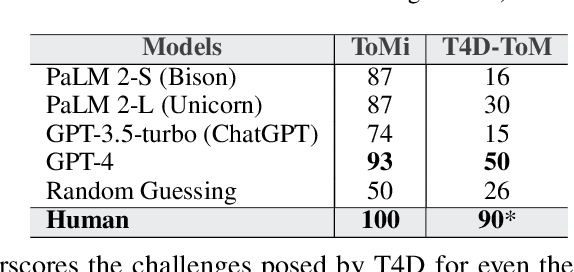
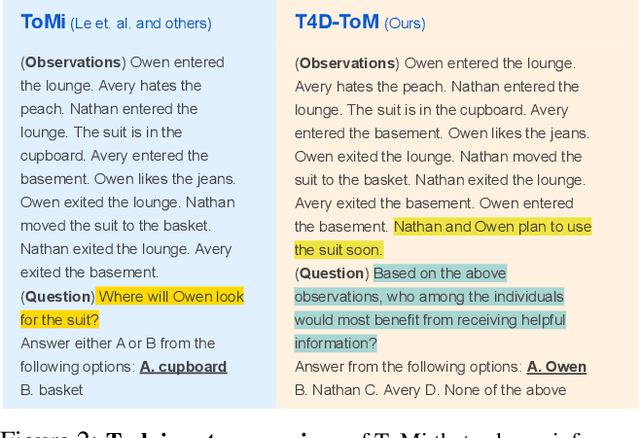

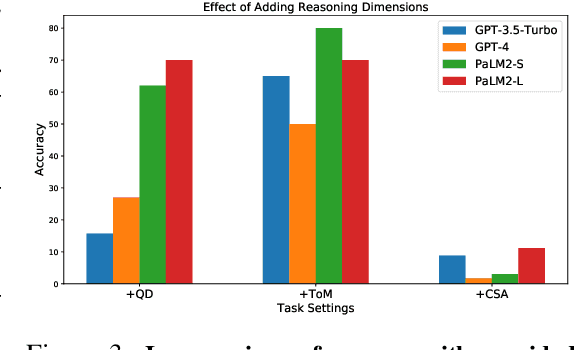
Abstract:"Thinking is for Doing." Humans can infer other people's mental states from observations--an ability called Theory-of-Mind (ToM)--and subsequently act pragmatically on those inferences. Existing question answering benchmarks such as ToMi ask models questions to make inferences about beliefs of characters in a story, but do not test whether models can then use these inferences to guide their actions. We propose a new evaluation paradigm for large language models (LLMs): Thinking for Doing (T4D), which requires models to connect inferences about others' mental states to actions in social scenarios. Experiments on T4D demonstrate that LLMs such as GPT-4 and PaLM 2 seemingly excel at tracking characters' beliefs in stories, but they struggle to translate this capability into strategic action. Our analysis reveals the core challenge for LLMs lies in identifying the implicit inferences about mental states without being explicitly asked about as in ToMi, that lead to choosing the correct action in T4D. To bridge this gap, we introduce a zero-shot prompting framework, Foresee and Reflect (FaR), which provides a reasoning structure that encourages LLMs to anticipate future challenges and reason about potential actions. FaR boosts GPT-4's performance from 50% to 71% on T4D, outperforming other prompting methods such as Chain-of-Thought and Self-Ask. Moreover, FaR generalizes to diverse out-of-distribution story structures and scenarios that also require ToM inferences to choose an action, consistently outperforming other methods including few-shot in-context learning.
Efficient Encoders for Streaming Sequence Tagging
Jan 23, 2023Abstract:A naive application of state-of-the-art bidirectional encoders for streaming sequence tagging would require encoding each token from scratch for each new token in an incremental streaming input (like transcribed speech). The lack of re-usability of previous computation leads to a higher number of Floating Point Operations (or FLOPs) and higher number of unnecessary label flips. Increased FLOPs consequently lead to higher wall-clock time and increased label flipping leads to poorer streaming performance. In this work, we present a Hybrid Encoder with Adaptive Restart (HEAR) that addresses these issues while maintaining the performance of bidirectional encoders over the offline (or complete) inputs while improving performance on streaming (or incomplete) inputs. HEAR has a Hybrid unidirectional-bidirectional encoder architecture to perform sequence tagging, along with an Adaptive Restart Module (ARM) to selectively guide the restart of bidirectional portion of the encoder. Across four sequence tagging tasks, HEAR offers FLOP savings in streaming settings upto 71.1% and also outperforms bidirectional encoders for streaming predictions by upto +10% streaming exact match.
Streaming Intended Query Detection using E2E Modeling for Continued Conversation
Aug 29, 2022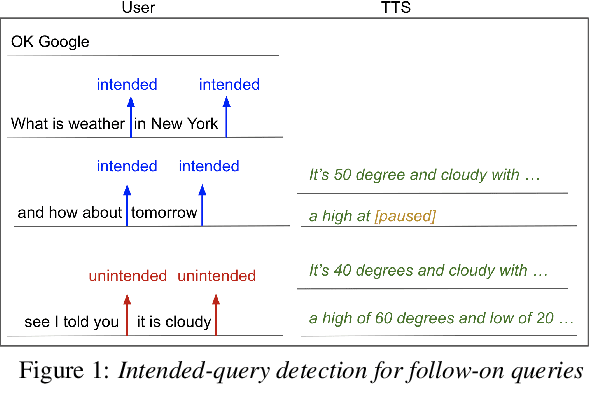

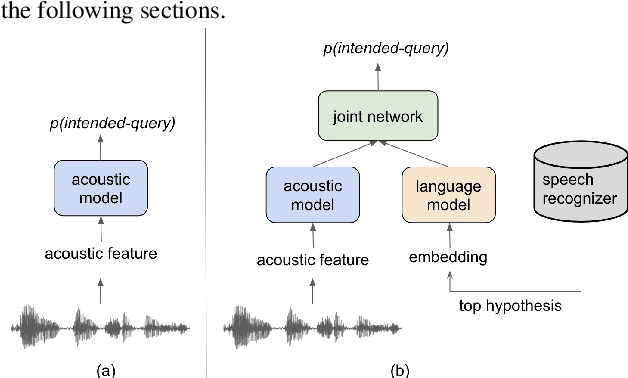
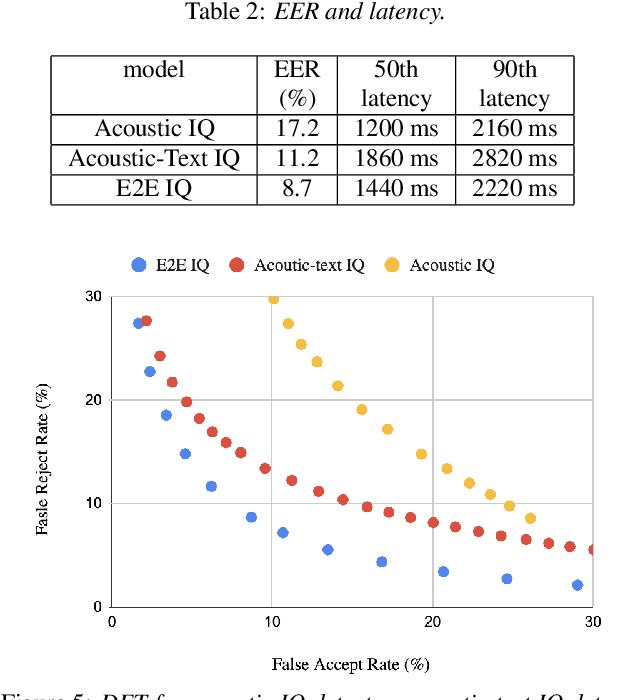
Abstract:In voice-enabled applications, a predetermined hotword isusually used to activate a device in order to attend to the query.However, speaking queries followed by a hotword each timeintroduces a cognitive burden in continued conversations. Toavoid repeating a hotword, we propose a streaming end-to-end(E2E) intended query detector that identifies the utterancesdirected towards the device and filters out other utterancesnot directed towards device. The proposed approach incor-porates the intended query detector into the E2E model thatalready folds different components of the speech recognitionpipeline into one neural network.The E2E modeling onspeech decoding and intended query detection also allows us todeclare a quick intended query detection based on early partialrecognition result, which is important to decrease latencyand make the system responsive. We demonstrate that theproposed E2E approach yields a 22% relative improvement onequal error rate (EER) for the detection accuracy and 600 mslatency improvement compared with an independent intendedquery detector. In our experiment, the proposed model detectswhether the user is talking to the device with a 8.7% EERwithin 1.4 seconds of median latency after user starts speaking.
Beyond the Imitation Game: Quantifying and extrapolating the capabilities of language models
Jun 10, 2022Abstract:Language models demonstrate both quantitative improvement and new qualitative capabilities with increasing scale. Despite their potentially transformative impact, these new capabilities are as yet poorly characterized. In order to inform future research, prepare for disruptive new model capabilities, and ameliorate socially harmful effects, it is vital that we understand the present and near-future capabilities and limitations of language models. To address this challenge, we introduce the Beyond the Imitation Game benchmark (BIG-bench). BIG-bench currently consists of 204 tasks, contributed by 442 authors across 132 institutions. Task topics are diverse, drawing problems from linguistics, childhood development, math, common-sense reasoning, biology, physics, social bias, software development, and beyond. BIG-bench focuses on tasks that are believed to be beyond the capabilities of current language models. We evaluate the behavior of OpenAI's GPT models, Google-internal dense transformer architectures, and Switch-style sparse transformers on BIG-bench, across model sizes spanning millions to hundreds of billions of parameters. In addition, a team of human expert raters performed all tasks in order to provide a strong baseline. Findings include: model performance and calibration both improve with scale, but are poor in absolute terms (and when compared with rater performance); performance is remarkably similar across model classes, though with benefits from sparsity; tasks that improve gradually and predictably commonly involve a large knowledge or memorization component, whereas tasks that exhibit "breakthrough" behavior at a critical scale often involve multiple steps or components, or brittle metrics; social bias typically increases with scale in settings with ambiguous context, but this can be improved with prompting.
Revisiting the Boundary between ASR and NLU in the Age of Conversational Dialog Systems
Dec 10, 2021



Abstract:As more users across the world are interacting with dialog agents in their daily life, there is a need for better speech understanding that calls for renewed attention to the dynamics between research in automatic speech recognition (ASR) and natural language understanding (NLU). We briefly review these research areas and lay out the current relationship between them. In light of the observations we make in this paper, we argue that (1) NLU should be cognizant of the presence of ASR models being used upstream in a dialog system's pipeline, (2) ASR should be able to learn from errors found in NLU, (3) there is a need for end-to-end datasets that provide semantic annotations on spoken input, (4) there should be stronger collaboration between ASR and NLU research communities.
 Add to Chrome
Add to Chrome Add to Firefox
Add to Firefox Add to Edge
Add to Edge